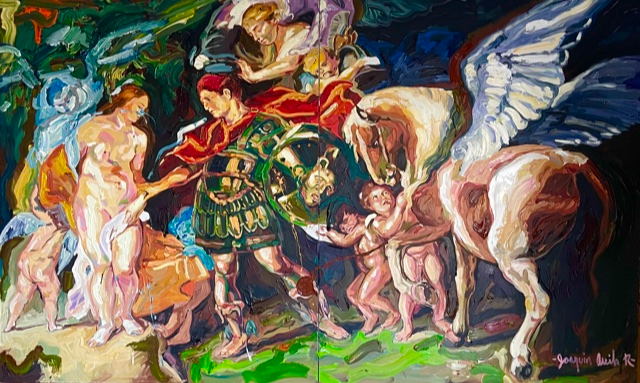From Havana to New York: Joaquín Ávila, reinterpreting the past
By Piter Ortega. Curator and Art Critic

Cuban artist Joaquín Ávila has discovered in the appropriation and recycling of art history the most solid path in his young creative career. His paintings make intertextuality, pastiche and parody the fundamental axes on which the discourse is articulated. Reviving classic paintings and bringing them to the present time is Ávila’s greatest obsession, but he has managed to do it with great creativity, humor, and delicious irony. Joaquín’s paintings are not naive at all. It is not about dusting off the past in a gratuitous or haphazard way, but trying to understand how much of that past lives in our present, how much we owe to those masters of art history, what is the moral, ethical, human and sociocultural legacy that those classics of universal painting offer us, how much life there is behind those old canvases.
Thus, when we look at the works by Joaquín Ávila, we come across versions of “The Abduction of the Daughters of Leucippus” by Peter Paul Rubens, “Las Meninas” by Velázquez or Leonardo Da Vinci’s “Mona Lisa”, among many others. But in all cases there is an essential and profound transformation that makes the works acquire a strongly contemporary dimension: the brushstroke. Joaquín uses a gestural, spontaneous, free stroke; a thick brushstroke full of fillings where there is no room for preconception, but everything flows in an improvised way. Ávila uses anything without fear or limits: he even paints with his own hands many times. That is why in his paintings the material paste is thick, dense, being the textures the great seductive element of his paintings. This is where all the contemporaneity comes from: the soft and delicate brushwork of the masters is now converted into a whirlwind of stains, paint grooves and colors that challenge the untrained viewer.
Other typical features of Joaquín’s paintings are strong color contrasts and movement. It’s about bold color combinations that hit us hard at first glance. Joaquín explores the chromatic range in all its extensions and in all its complexities. As for movement, it never ceases to exist in his paintings. Ávila needs the constant movement of lines and areas, mostly curved and sinuous, which give great eroticism and vitality to many works, as well as offer a dynamism in the compositions that we enjoy tremendously. There is no place for statism. That is a word that does not exist in Joaquín’s paintings. It seems that we are facing a hurricane of shapes and colors that mercilessly drags the past before our eyes, and returns it to us crushed, shaken.
Another important aspect in Ávila’s paintings is the monumentality of the formats. The artist likes huge paintings that shock the viewer from their very size. When I am in front of his works, I feel a kind of force, a sensation that something very big and powerful minimizes and annuls me. Maybe it’s about that past, “oppressing like a nightmare” my brain.
The “horror vacui” also distinguishes Joaquín’s style. His paintings are loaded, baroque. The artist is fascinated by filling the pictorial space and making the figure-ground relationship more complex. His human beings, animals and mythological themes fill the space in a visceral way.
At first glance, there is not much of Cuba in Joaquín’s paintings. They are rather universal proposals, oblivious to any local feeling or longing for the island where the artist was born and trained. However, in indifference and forgetfulness there is also a hidden way of loving. A silent way of carrying in our hearts that place where, one day, the artist -and many others- left in search of a better future.
Today Joaquín is in a moment of artistic maturity. He has found his own, personal, authentic path. He is already clear about the route to follow. The final success will be in discipline, in perseverance.
Something that Cuban artists have in abundance.
So let’s follow the clues of this young man full of dreams who has come to the Big Apple through the big door, and whose motto seems to be the famous phrase by E.B. White: “No one should come to New York to live unless he is willing to be lucky”
De La Habana a New York: Joaquín Ávila, reinterpretando el pasado
Por Piter Ortega. Curador y Crítico de Arte
El artista cubano Joaquín Ávila ha descubierto en la apropiación y el reciclaje de la historia del arte el camino más sólido dentro de su joven trayectoria creadora. Sus pinturas hacen de la intertextualidad, el pastiche y la parodia los ejes fundamentales sobre los cuales se articula el discurso. Revivir pinturas clásicas y traerlas al tiempo presente es la mayor obsesión de Ávila, pero ha sabido hacerlo con gran creatividad, humor y una deliciosa ironía. Las pinturas de Joaquín no son ingenuas, en lo absoluto. No se trata de desempolvar el pasado de una manera gratuita o azarosa, sino tratando de entender cuánto de ese pasado vive en nuestro presente, cuánto le debemos las generaciones actuales a esos maestros de la historia del arte, cuál es la enseñanza moral, ética, humana y sociocultural que nos brindan esos clásicos de la pintura universal, cuánta vida hay detrás de esos lienzos antiguos.
De este modo, cuando observamos las obras de Joaquín Ávila, nos topamos con versiones de “El rapto de las hijas de Leucipo”, de Pedro Pablo Rubens, “Las Meninas”, de Velázquez o la “Mona Lisa” de Leonardo Da Vinci, entre muchas otras. Pero en todos los casos hay una transformación esencial y profunda que hace que las obras adquieran una dimensión fuertemente contemporánea: la pincelada. Joaquín se vale de un trazo gestual, espontáneo, libre; una pincelada gruesa y llena de empastes donde no hay lugar para la preconcepción, sino que todo fluye de una manera improvisada. Ávila usa lo que sea sin temor ni límites: hasta pinta con sus propias manos muchas veces. Es por eso que en sus cuadros la pasta matérica es gruesa, densa, siendo las texturas el gran elemento seductor de sus pinturas. Es ahí donde viene toda la contemporaneidad: la pincelada suave y delicada de los maestros del pasado, es convertida ahora en un torbellino de manchas, surcos de pintura y colores que desafían al espectador no entrenado.
Otros rasgos típicos de las pinturas de Joaquín son los grandes contrastes cromáticos y el movimiento. Se trata de colores fuertes, con unas combinaciones atrevidas que nos golpean duro en una primera ojeada. Joaquín explora la gama cromática en toda su extensión y en todas sus complejidades. En cuanto al movimiento, este nunca deja de existir en sus cuadros. Ávila necesita el movimiento constante de líneas y áreas, mayormente curvas y sinuosas, las cuales les confieren gran erotismo y vitalidad a muchas obras, así como nos ofrecen un dinamismo en las composiciones que se disfruta tremendamente. No hay lugar para el estatismo. Esa es una palabra que no existe en las pinturas de Joaquín. Pareciera que estamos ante un huracán de formas y colores que arrastra el pasado sin piedad ante nuestros ojos, y nos lo devuelve estrujado, sacudido.
Otro aspecto importante en las pinturas de Ávila es la monumentalidad de los formatos. Al artista le gustan los cuadros enormes, que impactan al espectador desde el tamaño mismo. Cuando estoy frente a sus trabajos, siento una especie de fuerza, una sensación de que algo muy grande y poderoso me minimiza y anula. Quizás se trata de ese pasado, “oprimiendo como una pesadilla” mi cerebro.
El “horror vacui” u horror al vacío también distingue al estilo de Joaquín. Sus pinturas son cargadas, barrocas. Al artista le fascina llenar el espacio pictórico y complejizar la relación figura-fondo. Sus seres humanos, animales y temas mitológicos llenan el espacio de una manera visceral.
A simple vista, no hay mucho de Cuba en las pinturas de Joaquín. Son más bien propuestas universales, ajenas a cualquier sentimiento local o añoranza con respecto a la isla donde nació y se formó el artista. Sin embargo, en la indiferencia y el olvido hay también una forma oculta de amar. Una manera silenciosa de llevar en el corazón ese lugar de donde, un día, el artista -y muchos- salimos en busca de un mejor futuro.
Hoy Joaquín está en un momento de madurez artística. Ha encontrado un camino propio, personal, auténtico. Ya él está claro de cuál es el sendero a seguir. El éxito final estará en la disciplina, en la constancia.
Algo que los artistas cubanos tienen en abundancia.
Sigámosle entonces las pistas a este joven lleno de sueños que ha llegado a la Gran Manzana por la puerta grande, y cuyo lema pareciera ser la célebre frase de E.B. White: “Nadie debería venir a Nueva York a menos que tenga la intención de ser afortunado”.
